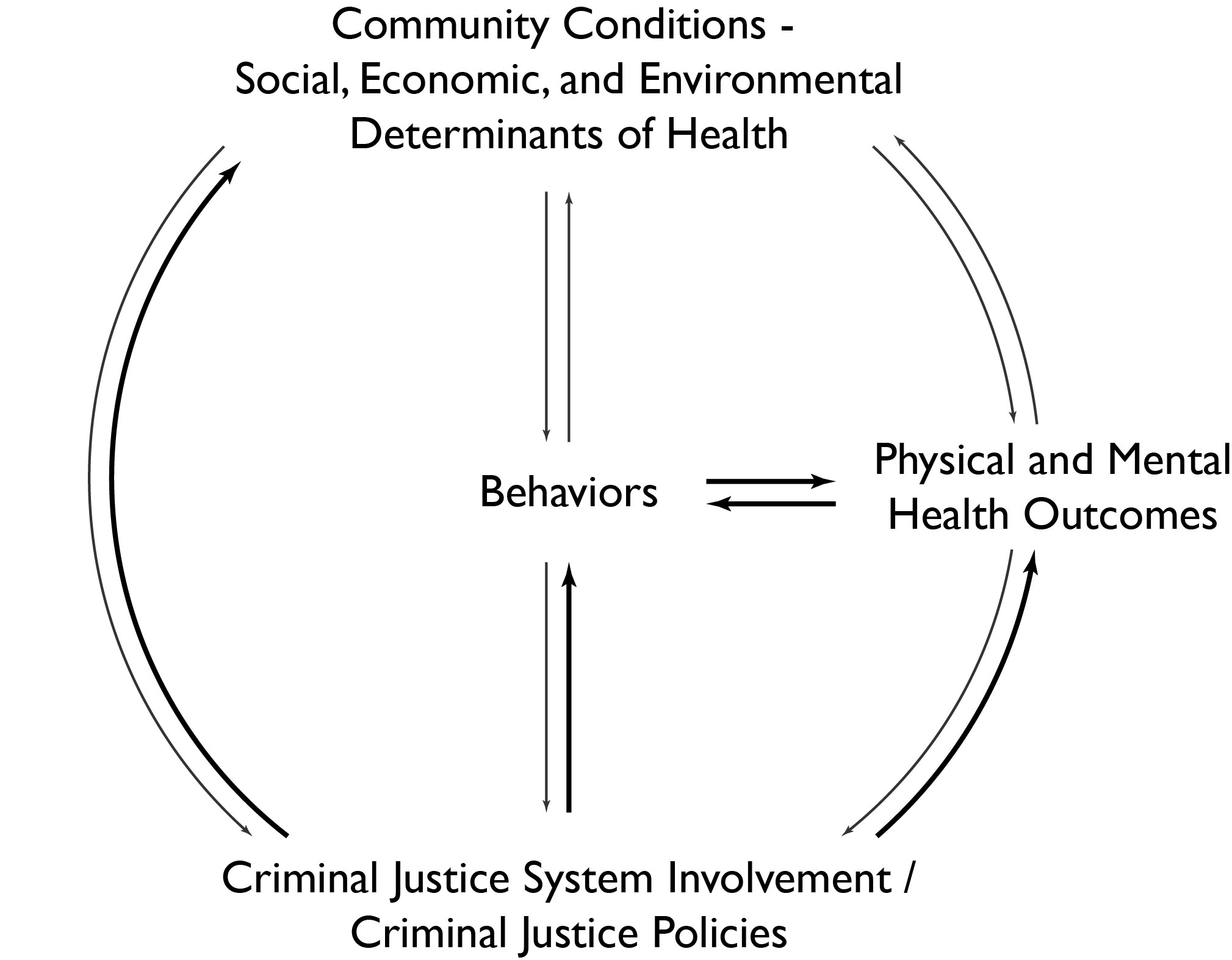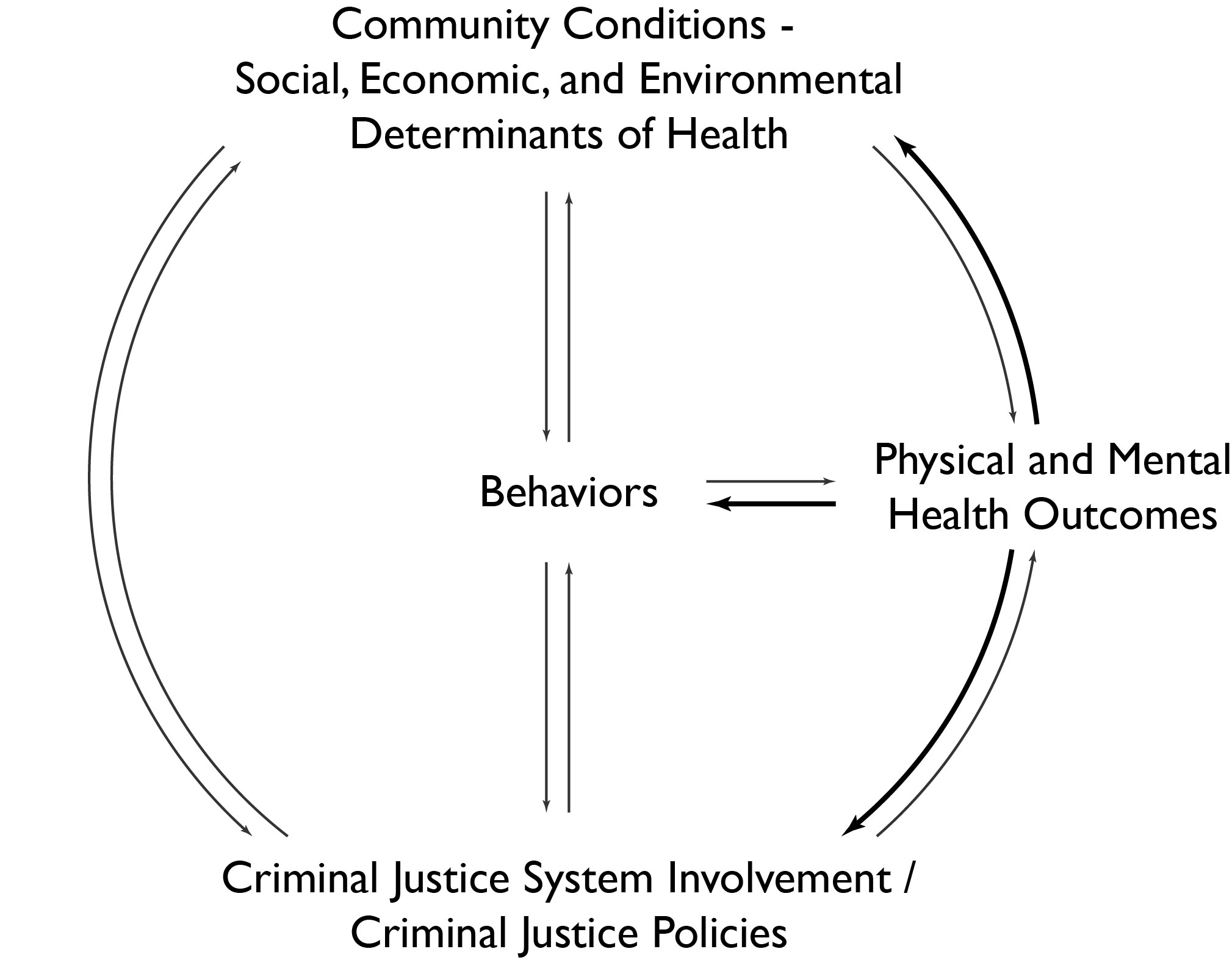UPDATE: Our Health Instead of Punishment Program has undergone some exciting updates since we published this blog post. We invite you to learn about our latest work over here.
| By Jonathan Heller |
HIP has been doing a lot of research about how criminal justice policies and practices affect health. As our work to understand these impacts has evolved, we are more and more convinced that it is a public health imperative to use the power of public health to re-envision and change our justice system and virtually all its component parts.
 As conveners of the National Criminal Justice and Public Health Alliance, we’ve also been thinking a lot about how the determinants of health are more or less the same as the determinants of justice system involvement. Others are also thinking about criminal justice as a public health issue by: changing behaviors related to violence; addressing the traumas that victims face and how those perpetuate crime; reducing Adverse Childhood Experiences; ensuring those leaving prison sign up for Obamacare; and working to reinvest savings from criminal justice reform back into our hardest hit communities.
As conveners of the National Criminal Justice and Public Health Alliance, we’ve also been thinking a lot about how the determinants of health are more or less the same as the determinants of justice system involvement. Others are also thinking about criminal justice as a public health issue by: changing behaviors related to violence; addressing the traumas that victims face and how those perpetuate crime; reducing Adverse Childhood Experiences; ensuring those leaving prison sign up for Obamacare; and working to reinvest savings from criminal justice reform back into our hardest hit communities.
All these approaches are necessary to addressing the health and social needs of those who are justice involved. It’s useful to also think about how these individual and community level interventions tie together into a criminal justice and public health framework. This diagram represents a way of thinking about these relationships and how change in any one domain might affect change in another domain.
First, let me give examples of what is included in each element of the diagram:
- Community Conditions – Social, Economic, and Environmental Determinants of Health includes employment, housing, and education; exposure to environmental contaminants like lead as well as access to healthy food; and poverty, racism and other forms of oppression, and empowerment.
- Physical and Mental Health Outcomes includes chronic disease (e.g., cardiovascular disease, diabetes); infectious disease (e.g., AIDS, hepatitis); developmental issues; stress, anxiety, depression, and trauma; and preterm birth, infant mortality, and premature mortality.
- Behaviors include substance abuse, theft, and violence as well as eating a healthy diet and getting exercise.
- Criminal Justice System Involvement / Criminal Justice Policies includes involvement in system as well as policies that govern all aspects of the criminal justice system including school discipline and the school-to-prison pipeline; policing; pre-trial, prosecution, defense, adjudication, and sentencing; incarceration; and release and re-entry.
Here are some examples (though not a comprehensive list) of how elements of the framework shown in the diagram simultaneously interact with each other to generate poor health and justice system involvement.
Examples: How factors that shape health affect justice involvement, behaviors, and health outcomes
 Determinants of health can affect criminal justice involvement, behaviors, and physical and mental health outcomes through:
Determinants of health can affect criminal justice involvement, behaviors, and physical and mental health outcomes through:
- Homelessness and poverty are criminalized, leading to justice system involvement
- Both structural and institutional racism lead to over-policing of black communities and disproportionate punishment of people of color throughout the justice system.
- Lead exposure in childhood leads to developmental delays, behavioral issues, and crime.
- Unemployment can lead to a host of behavioral issues: drug use, involvement in the underground economy, theft, and various forms of violence.
- Conditions that lead to Adverse Childhood Experiences, such as exposure to violence in the community, homelessness, or incarceration of a parent, can lead to behavioral issues in school and beyond, substance abuse, as well as mental health disorders.
Examples: How justice involvement affects factors that shape health and health outcomes
Criminal justice involvement and policies can affect determinants of
determinants of
health, behaviors, and physical and mental health outcomes through:
- People re-entering society face collateral consequences of justice system involvement, such as difficulty finding employment and housing.
- Experiences while incarcerated, including traumas from physical, sexual, and mental abuse, and from isolation, can lead to drug use and further violence.
- The presence or absence of rehabilitative programs while incarcerated influence recidivism upon release.
- Restorative justice practices as an alternative to incarceration influences
Examples: How health outcomes affect justice involvement and factors that shape health
Physical and mental health outcomes can affect criminal justice  involvement and determinants of health through:
involvement and determinants of health through:
- Physical or mental health issues can lead to unemployment and housing instability.
- Mental health crises can lead to arrest.
- Debt from health care expenses can lead to inability to pay bills, poverty, and arrest.
How can this framework be used?
This framework provides public health and criminal justice reform advocates a common basis for talking about work to create a more just criminal justice system that creates the conditions necessary for people to succeed and therefore healthy and safe communities. Those seeking change in any element of the framework should recognize that their efforts are linked to other elements and therefore a) consider the relationship and consequences of their work on those other elements and b) build relationships with others working on other parts of the framework to think about how all efforts can reinforce one another. The less our work is isolated, the better the outcomes we will realize.
For example, many proposed criminal justice reforms can be analyzed using this framework. Our Health Impact Assessments ask how these reforms – in policing, sentencing, access to education in prison, for example – influence physical and mental health outcomes directly, and through changes in the other two elements – behaviors and determinants of health.
As we continue work with the National Criminal Justice and Public Health Alliance, we’ll make sure we represent the different aspects of the framework in our discussions and continue to strengthen relationships between the groups doing this work. We have already collaborated to create a vision for a criminal justice system that operates from public health principles. Should this vision be realized, it would improve upon virtually all elements of the framework and lead to improved health and justice system outcomes.
We hope the framework is useful to others doing work at the intersection of criminal justice and public health. We’d love to hear your thoughts!




